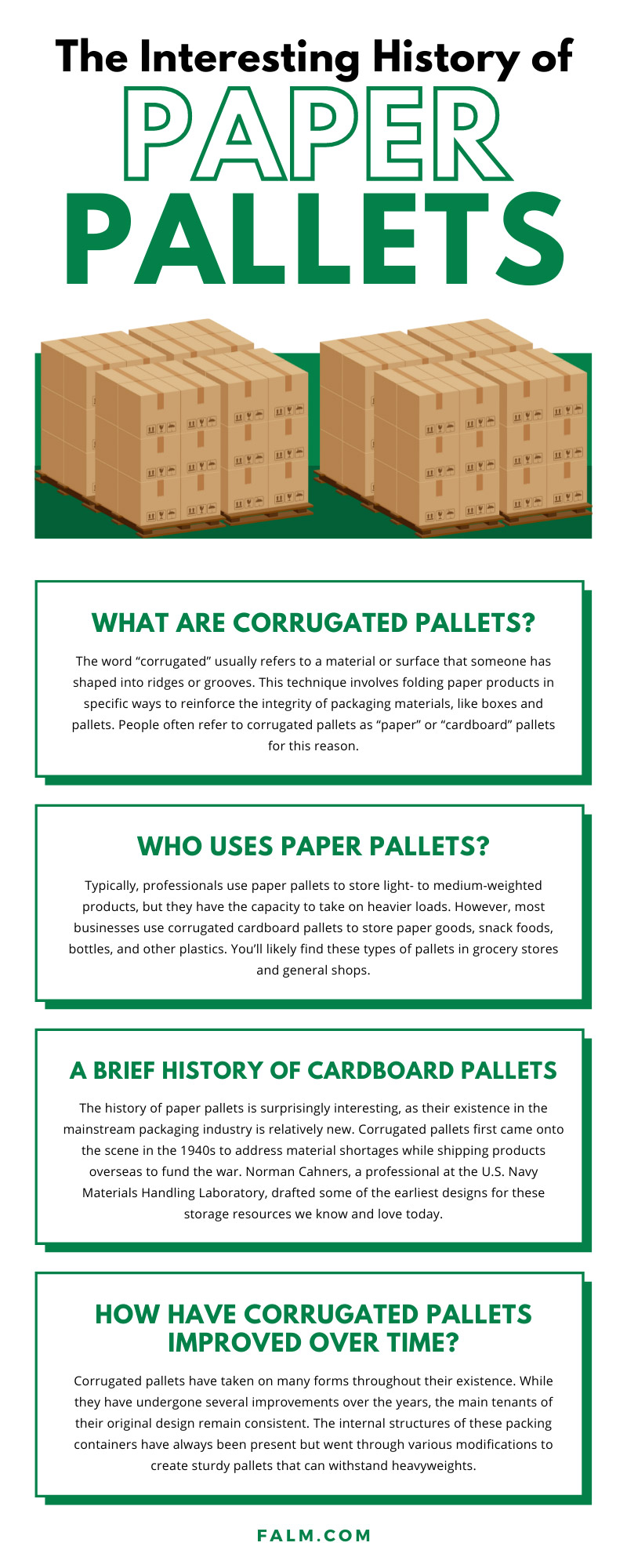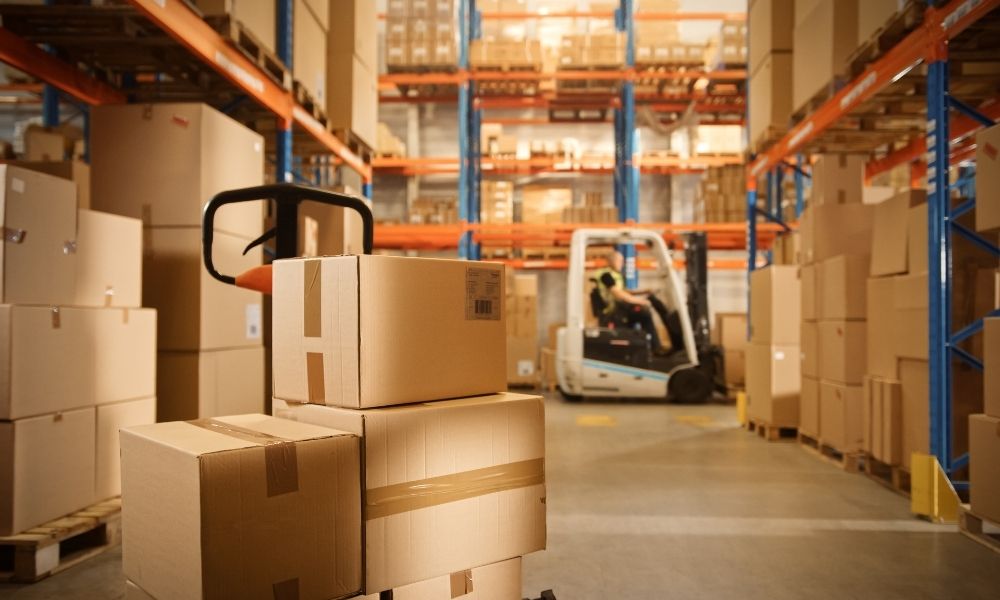- By First Alliance Logistics Management
- June 6, 2022
- Buying Pallets
When it comes to logistics management, it’s helpful to have multiple pallet sources to fit various business needs. Traditionally, wooden pallets have been the standard for storage facilities across several industries but don’t always perform the way certain companies need them. Fortunately, experts have been working on developing alternative resources to help these entities deal with their packaging problems.
Enter corrugated pallets—a new way for the storage and shipping industries to handle goods without the hassle of their wood or metal counterparts. But what exactly makes these items so unique? Keep reading to learn about the interesting history of paper pallets and how they can impact your business operations.
What Are Corrugated Pallets?
The word “corrugated” usually refers to a material or surface that someone has shaped into ridges or grooves. This technique involves folding paper products in specific ways to reinforce the integrity of packaging materials, like boxes and pallets. People often refer to corrugated pallets as “paper” or “cardboard” pallets for this reason.
You might not think that cardboard or paper has the strength to contain sharp, heavy items; the truth is that these materials are more durable than you imagine. Through trial and error, packaging experts have experimented with various designs to develop perfect corrugated cardboard pallets.
Who Uses Paper Pallets?
Typically, professionals use paper pallets to store light- to medium-weighted products, but they have the capacity to take on heavier loads. However, most businesses use corrugated cardboard pallets to store paper goods, snack foods, bottles, and other plastics. You’ll likely find these types of pallets in grocery stores and general shops.
Paper pallets don’t just have storage applications. Professionals also use these resources to organize, ship, stock, and display items for consumers. Cardboard pallets are incredibly versatile, making them the ideal material for businesses to have on hand to address all kinds of concerns.
A Brief History of Cardboard Pallets
The history of paper pallets is surprisingly interesting, as their existence in the mainstream packaging industry is relatively new. Corrugated pallets first came onto the scene in the 1940s to address material shortages while shipping products overseas to fund the war. Norman Cahners, a professional at the U.S. Navy Materials Handling Laboratory, drafted some of the earliest designs for these storage resources we know and love today.
Cahner outlined the potential benefits that corrugated cardboard pallets had over their wooden and metal contemporaries in his 1945 patent. The main goal of the preliminary schematics was to design a lightweight transportation vessel that would cut moving costs and take up less space. These enhancements proved essential during future international affairs transporting important goods to U.S. troops stationed in foreign lands.
The popularity of paper pallets continued to grow over the years, with a huge spike in demand occurring in the late 20th century. As personal and professional recycling initiatives gained more traction in the 1990s, businesses and manufacturers turned to these resources to improve their brand image and reduce their overall environmental impact. This trend has continued to overtake mainstream consumer habits, with cardboard pallets accounting for millions of dollars in the paper goods and packaging industries.
How Have Corrugated Pallets Improved Over Time?
Corrugated pallets have taken on many forms throughout their existence. While they have undergone several improvements over the years, the main tenants of their original design remain consistent. The internal structures of these packing containers have always been present but went through various modifications to create sturdy pallets that can withstand heavyweights.
As technology advanced in the storage and shipping sectors, paper pallets needed to adapt. While early structures featured core tubes as the main support, experts needed to design new models to compliment forklifts and other pieces of equipment that took over transportation. Corrugated pallets needed space for lift farms while remaining durable, prompting professionals to create pallets with the internal honeycomb structures we are familiar with today.
Other aspects of paper pallets have undergone massive improvements over time. Manufacturers have developed new ways to build these resources to cut down on production costs and optimize them for automation. In addition, cardboard pallets have protection against moisture and sharp edges, allowing people to use them to store and ship nontraditional goods.
Advantages of Corrugated Pallets
While durability is an essential quality, there are so many other benefits that make these shipping containers worthwhile. It’s evident that corrugated pallets are stronger than they appear. But what are some of the other advantages of using paper pallets?
Lightweight
Cardboard pallets are significantly lighter than wood or metal pallets. Not only does this make them easier to handle, but it also reduces transportation costs. The heavier an item is, the more power you need to move it from point A to point B. Using a lightweight shipping method cuts fuel costs and decreases the amount of nonrenewable resources a business uses to ship things from various locations.
Hygienic
Wooden pallets must undergo treatments to kill off any bacteria lingering inside the lumber. However, corrugated pallets are less likely to develop mold, mildew, and other potential health hazards, making them the more hygienic option. Professionals operating in cleanrooms and other sterile environments can use paper pallets since they won’t contaminate the space and negatively impact the production of sensitive goods, like medical equipment and pharmaceuticals.
Sustainable
As society continues to prioritize sustainability in almost all sectors, paper pallets are ideal materials since they are easily repurposed. Corrugated pallets are eco-friendly, since professionals can create them from 100% recyclable material. Their “green” qualities don’t stop there; once a cardboard pallet retires, there are so many ways to reuse them, from creating new pallets to repurposing them for other projects. They are also biodegradable and contain non-hazardous compounds that won’t harm the environment as they decompose.
Safe
As the name suggests, paper pallets are made from paper. As such, there’s no need to use staples, nails, or splintering wood that could injure anyone handling them. Since they carry less weight than traditional wood or metal pallets, workers are less likely to drop them and hurt themselves and their environments. Even if they do have an accident, the impact of cardboard pallets is so insignificant that any mishap would have very little influence on your business’ workflow.
Now that you know the history of paper pallets, you can make a better decision regarding storage and shipping materials that meet your specific needs. Visit our website today to learn more about your logistics options to improve your operations.


